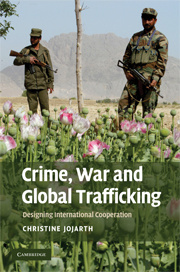Description
Crime, War, and Global Trafficking
Designing International Cooperation
Author: Jojarth Christine
Asks whether governments choose the best institutional designs to enable effective measures against criminal trafficking.
Language: English
Subject for Crime, War, and Global Trafficking:
Approximative price 100.60 €
Subject to availability at the publisher.
Add to cart
Crime, war and global trafficking: designing international cooperation
Publication date: 04-2009
342 p. · 15.7x23.4 cm
Publication date: 04-2009
342 p. · 15.7x23.4 cm
Approximative price 37.68 €
Subject to availability at the publisher.
Add to cart
Crime, war and global trafficking: designing international cooperation
Publication date: 04-2009
342 p. · 15.2x22.8 cm
Publication date: 04-2009
342 p. · 15.2x22.8 cm
Description
/li>Contents
/li>Biography
/li>
Globalization creates lucrative opportunities for traffickers of drugs, dirty money, blood diamonds, weapons, and other contraband. Effective countermeasures require international collaboration, but what if some countries suffer while others profit from illicit trade? Only international institutions with strong compliance mechanisms can ensure that profiteers will not dodge their law enforcement responsibilities. However, the effectiveness of these institutions may also depend on their ability to flexibly adjust to fast-changing environments. Combining international legal theory and transaction cost economics, this book develops a novel, comprehensive framework which reveals the factors that determine the optimal balance between institutional credibility and flexibility. The author tests this rational design paradigm on four recent anti-trafficking efforts: narcotics, money laundering, conflict diamonds, and small arms. She sheds light on the reasons why policymakers sometimes adopt suboptimal design solutions and unearths a nascent trend toward innovative forms of international cooperation which transcend the limitations of national sovereignty.
1. Introduction; 2. The concept of legalization; 3. Problem constellation; 4. Narcotic drugs: UN Convention against Illicit Traffic in Narcotic Drugs and Psychotropic Substances; 5. Money laundering: the Financial Action Task Force and its Forty Recommendations; 6. Conflict diamonds: the Kimberley Process Certification Scheme; 7. Small arms and light weapons: the United Nations Program of Action; 8. Conclusion.
Christine Jojarth is Social Science Research Associate at the Center on Democracy, Development, and the Rule of Law at Stanford University.
© 2024 LAVOISIER S.A.S.

